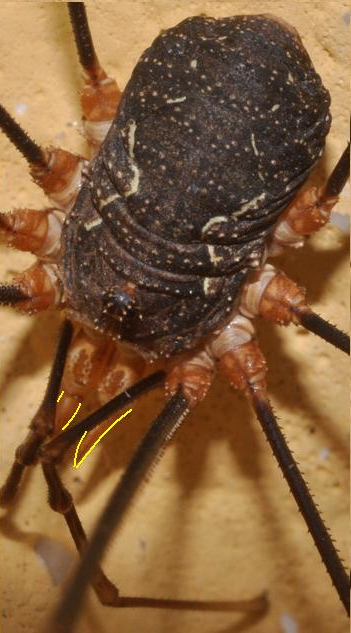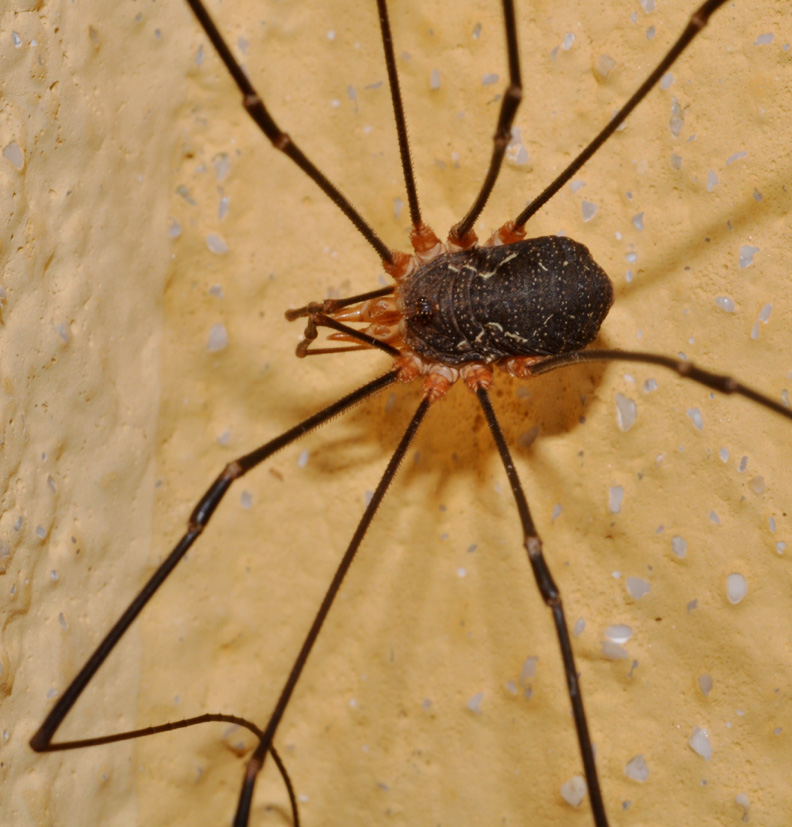|
|
|
|
|
Galleria Tassonomica
di
Natura Mediterraneo
|
 ATTENZIONE! Con tutti gli opilionidi è estremamente importante vedere l'oculario e la zona di fronte ad esso. Questo è vero in particolare per gli opilionidi a zampe corte nei quali il tridente è una caratteristica distintiva. ATTENZIONE! Con tutti gli opilionidi è estremamente importante vedere l'oculario e la zona di fronte ad esso. Questo è vero in particolare per gli opilionidi a zampe corte nei quali il tridente è una caratteristica distintiva.
Si dovrebbe misurare la lunghezza del corpo. Se è possibile scattare fotografie prese dall'alto e di lato. Naturalmente non dovrebbe mancare una semplice foto dorsale. Anche se sono la caratteristica più notevole degli opilionidi, le zampe possono essere ignorate senza problemi perché non hanno virtualmente alcun ruolo nella determinazione.
Per la maggior parte degli Opiliones si arriva ad una determinazione già con le foto. Le eccezioni sono Nemastomatidae ('i piccoli neri') e soprattutto Trogulidae, per i quali è meglio l'analisi del DNA.
|
|
| Autore |
 Discussione Discussione  |
|
|
ff57
Utente Super
    
Città: Cavriglia
Prov.: Arezzo
Regione: Toscana

6271 Messaggi
Tutti i Forum |
|
|
Cmb
Moderatore
    

Città: Buers
Prov.: Estero
Regione: Austria

12844 Messaggi
Flora e Fauna |
 Inserito il - 18 gennaio 2012 : 22:20:16 Inserito il - 18 gennaio 2012 : 22:20:16


|
Con Link comma V si arriva a Phalangium opilio Linnaeus 1758 comma V si arriva a Phalangium opilio Linnaeus 1758
fotomontaggio di Lars Friman:

163,16 KB |
 |
|
|
Cmb
Moderatore
    

Città: Buers
Prov.: Estero
Regione: Austria

12844 Messaggi
Flora e Fauna |
 Inserito il - 20 gennaio 2012 : 00:30:29 Inserito il - 20 gennaio 2012 : 00:30:29


|
Wow, a beautiful animal. I can only encourage to collect even these common animals for genetics. For now it is Phalangium opilio but Spanish specimens are already different...
det. A. Schönhofer: Link
    
"La distinction des espèces de limaces est extrêmement difficile,
et aucun zoologiste n’est encore parvenu à quelque chose
d’un peu satisfaisant sous ce rapport."
H. M. DUCROTAY DE BLAINVILLE 1823
Vieni nel mondo dei Limax d'Italia

|
 |
|
|
ff57
Utente Super
    
Città: Cavriglia
Prov.: Arezzo
Regione: Toscana

6271 Messaggi
Tutti i Forum |
 Inserito il - 20 gennaio 2012 : 22:57:49 Inserito il - 20 gennaio 2012 : 22:57:49


|
Di questo esemplare ho un altra immagine dove si vede meglio quanto evidenziato da Clemens.
Immagine:

212,24 KB |
 |
|
|
Cmb
Moderatore
    

Città: Buers
Prov.: Estero
Regione: Austria

12844 Messaggi
Flora e Fauna |
 Inserito il - 22 gennaio 2012 : 19:01:09 Inserito il - 22 gennaio 2012 : 19:01:09


|
Vedi: Link
anche questo esemplare della provinzia di Potenza è nera!
"La distinction des espèces de limaces est extrêmement difficile,
et aucun zoologiste n’est encore parvenu à quelque chose
d’un peu satisfaisant sous ce rapport."
H. M. DUCROTAY DE BLAINVILLE 1823
Vieni nel mondo dei Limax d'Italia

|
 |
|
|
Lars Friman
Utente Senior
   
Città: D-14806 Bad Belzig

680 Messaggi
Flora e Fauna |
 Inserito il - 22 gennaio 2012 : 22:52:19 Inserito il - 22 gennaio 2012 : 22:52:19


|
Moin ff57,
I have modified Your picture in our Forum a little for the Identification of Your dark Phalangiinae.
It ist (still) a Phalangium cf. opilio but it might be a new species. So can I use Your Foto in our
Forum Link to show, how different the spiecies of the genus Phalangium can be. to show, how different the spiecies of the genus Phalangium can be.
Lars Friman
P.S. Do You collect also specimens for scientific identifications? |
 |
|
|
ff57
Utente Super
    
Città: Cavriglia
Prov.: Arezzo
Regione: Toscana

6271 Messaggi
Tutti i Forum |
 Inserito il - 24 gennaio 2012 : 23:22:41 Inserito il - 24 gennaio 2012 : 23:22:41


|
| Messaggio originario di Lars Friman:
Moin ff57,
I have modified Your picture in our Forum a little for the Identification of Your dark Phalangiinae.
It ist (still) a Phalangium cf. opilio but it might be a new species. So can I use Your Foto in our
Forum Link to show, how different the spiecies of the genus Phalangium can be. to show, how different the spiecies of the genus Phalangium can be.
Lars Friman
P.S. Do You collect also specimens for scientific identifications?
|
Dear Lars,
No problem to use the photo in your forum.
I do not collect specimens, but merely trying to photograph, with the help of experts, to identify them to have a photographic archive. Let me know in the case of a new species, the contribution would be happy.
Regards
Franco Fiaschi (ff57) |
 |
|
| |
 Discussione Discussione  |
|
|
|
 Natura Mediterraneo Natura Mediterraneo |
© 2003-2024 Natura Mediterraneo |
 |
|
Leps.it | Herp.it | Lynkos.net
|

 Forum
|
Registrati
|
Msg attivi
|
Msg Recenti
|
Msg Pvt
|
Utenti
|
Galleria |
Map |
Forum
|
Registrati
|
Msg attivi
|
Msg Recenti
|
Msg Pvt
|
Utenti
|
Galleria |
Map |